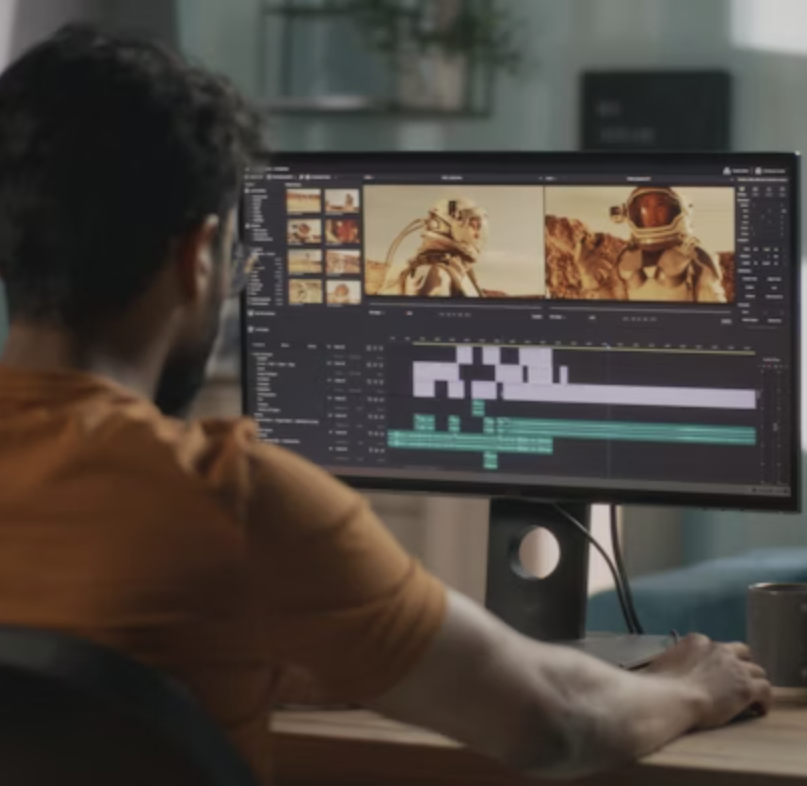This intensive one-year program equips you with the skills and knowledge to thrive in the ever-evolving landscape of new media. You'll explore the fundamentals of creating engaging content, crafting compelling narratives, and utilizing cutting-edge technologies to tell your stories in innovative ways.
Who is this program for?
Aspiring creative professionals with a passion for storytelling and new media platforms
Individuals seeking a career shift into content creation, video production or digital media marketing
Entrepreneurs looking to develop their online brand and engage with audiences effectively
Aspiring creative professionals with a passion for storytelling and new media platforms
Individuals seeking a career shift into content creation, video production or digital media marketing
Entrepreneurs looking to develop their online brand and engage with audiences effectively
NEW MEDIA PRODUCTION COURSES
|
Fundamentals of New Media (6 Units)
Are you outgoing? Do you sometimes like to tell stories or pretend you’re someone else? Maybe you’ve thought about trying acting? Well, here’s your chance! In this class, you’ll learn from top Hollywood talent the basics of how to act, perform, and maybe even become a digital star! Discover how to express yourself individually and how to work as a web-team, gaining valuable leadership skills while having fun and making friends. Learn how to create engaging, compelling characters, and make every role shareworthy. Acting Fundamentals for New Media (6 Units) Nowadays, just about everyone wants to become a YouTube star. But there are over 500 hours of video uploaded to YouTube every minute, so how can you possibly get discovered? Here’s how. This class details how to make videos and video series that generate so much excitement, your bodyguard will need a bodyguard. From brainstorming cool concepts to building your personal brand and cashing in on paid production and distribution opportunities, learn how NOT to get lost in the vast wasteland of crap that gets uploaded to YouTube every minute. New Media Videography, Lighting and Sound Techniques (6 Units) If you own a mobile phone, you already have the gear to make videos. But if you want to make videos like the pros do, you’ll need the mad-skills like the pros have, which no amount of fancy gear can make up for. Video-making is an art, and art takes practice. In this class, you’ll practice framing and composition, picture enhancement, shot technique, coverage, sound, lighting, and how to bring your ideas to life and capture the spectacular. Brand Development: Theory and Practice (6 Units) Back in the 20th Century, you had to be Rockefeller-rich to build a personal brand. Nowadays, anyone with a snappy idea and clever no-budget execution can attract an audience of millions. In this extraordinary class, you’ll learn how to build, implement and present a personal brand in the digital age. New Media Writing I: Writing a Digital Series Pilot (6 Units) At traditional media film schools, they teach the history of 20th Century filmmaking. At Virtual Film School, we teach the history of 21st Century digital content creation, because if you know the success stories of social media history, you’re bound to repeat it. Ever wonder why the Grumpy Cat meme earned $100 million dollars, book and merchandising deals, and even a Lifetime movie? Now you can learn how to create content that’s relevant and trending in a digitally dominated social landscape. New Media Writing II: Writing a Digital Series (6 Units) The web shows that win all the awards and cash are the best written. Period. But you have to be a mega-genius to write a hit digital series, right? Wrong. All you have to do is work at it. But you have to work in the right direction. Otherwise, you’re just spinning your wheels like a caffeinated hamster. Learn how to play to the strengths of the small screen and create series of concepts that work for the Web. In this master class, you’ll create a web series pitch bible, a; business plan, a pilot script, and the first three episodes of your webisode series. Online Video Directing (6 Units) Are you inspired by famous Hollywood directors like Steven Spielberg or Freddie Wong? Do you like telling people what to do? What to say? And how to say it? Then you just might be a director (or a jerk, but let’s just go with the director for now). In this awe-inspiring class, you’ll learn the art of visual storytelling, how to create a shot list and storyboards, how to work with producers, casting directors, actors, production designers and cinematographers, while gaining confidence and leadership skills. Online Video Pre-Production and Producing (6 Units) You’ve got a great concept. You’ve got a great script. But if you want to save time and money, preproduction is best done before the shoot. This valuable class demystifies scheduling and budgeting, prop shopping, location scouting, greenscreen and set construction, call sheets, clearances, permissions and more and shows you how to pull it all together before the director first calls action. Online Video Production: Producing and Shooting a Digital Series (6 Units) Dreamers may dream, but producers produce results. Students will learn why producing is like “herding cats” while they produce a webisode series from ideation to script-lock to financing, casting, shooting, editing, re-shooting, and all the other aspects of post-production. Online Video Editing and Audio Post-Production (6 Units) Congratulations! You produced a digital series. Now it’s time to start editing (aka, the process of turning a bunch of un-matching, spottily lit, badly framed shots into shareworthy content). Learn editing theory and techniques, how to export video, audio editing, titles and color correction, the art of the trailer, and edit your own project as well as your classmate’s work. If your video sounds good, it is good. Learn from top Hollywood producers the basics of sound design and how to sound like a pro -- even on a bubblegum and shoestring budget. |




